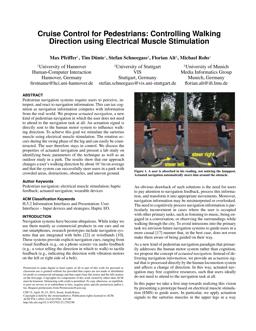Pedestrian navigation systems require users to perceive, interpret, and react to navigation information. This can tax cognition as navigation information competes with information from the real world. We propose actuated navigation, a new kind of pedestrian navigation in which the user does not need to attend to the navigation task at all. An actuation signal is directly sent to the human motor system to influence walking direction. To achieve this goal we stimulate the sartorius muscle using electrical muscle stimulation. The rotation occurs during the swing phase of the leg and can easily be counteracted. The user therefore stays in control. We discuss the properties of actuated navigation and present a lab study on identifying basic parameters of the technique as well as an outdoor study in a park. The results show that our approach changes a user’s walking direction by about 16°/m on average and that the system can successfully steer users in a park with crowded areas, distractions, obstacles, and uneven ground.
Publikation
 |
Max Pfeiffer, Tim Dünte, Stefan Schneegass, Florian Alt und Michael Rohs. Cruise Control for Pedestrians: Controlling Walking Direction Using Electrical Muscle Stimulation. In Proceedings of the 33rd Annual ACM Conference on Human Factors in Computing Systems. CHI '15. ACM, New York, NY, USA. [Download Bibtex] |